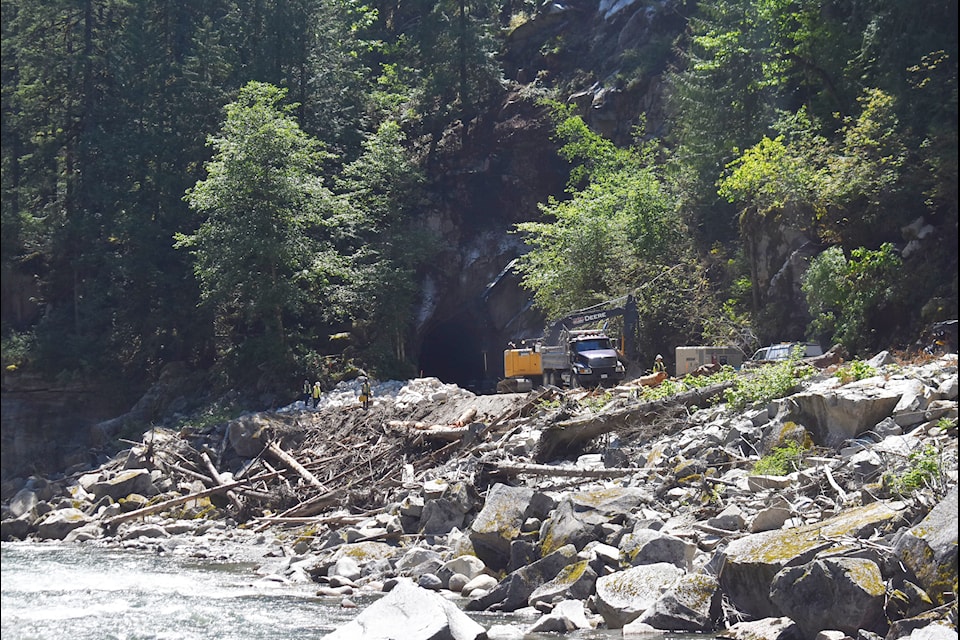A portion of the popular Othello Tunnels trail will re-open to the public in the second week of July.
The trails, which are in Coquihalla Canyon Park just outside of Hope, were heavily damaged in November 2021 in the historic atmospheric river event.
The first phase of restoration work is already underway, and the province has now announced that the first two tunnels along the trail will be ready for this summer season of tourism. Officials toured the site with media on Thursday, June 20, confirming what the province had announced in the spring this year.
"We decided to do this project in two phases so that we can open it this year rather than wait for the completion of all of the phases in 2025," said George Heyman, the Minister of Environment and Climate Change Strategy. This was his first time visiting the tunnels. "I think the people of Hope take pride in the beautiful scenery around here. And the tunnels and this park is an important part of it. And I hope that the people of Hope will feel really good about the upcoming opening of the Othello Tunnels."
More than 30 areas of the park were damaged in 2021, including the tunnels, which were created in 1914 for the rail lines.
Bridge foundations were also affected, along with the stability of the canyon slopes above and inside the tunnels, increasing the risk of falling rocks. Local access roads and trails were also eroded by the flooding.
Many were initially concerned that the park would never receive the funding required to restore access, which would be a major hit to Hope's tourism. However, this recent restoration work will allow people to access the park via the parking lot through to the end of the second tunnel.
"It's big for our town," said Mayor Victor Smith. "This is one of our top attractions. It's one of the top things asked about at the Visitor Centre. And we're known everywhere in the world for this place. Because what a history it has! It has amazing history. And it's an easy walk. It's flat. On a hot day there's no better place to be than out there. It's nice and cool along the way.
"This is great for us. We thank the government for investing in this and bringing it back up to par. So, we're pretty excited."
Heyman said he recognized how important it was that at least part of the tunnels be re-opened for the people of Hope; he hopes that the partial re-opening will help bring people and revenue back to the community, and will "make the area thrive again."
Work on the project began in April with the province understanding, according to Heyman, that restoration of the entire area would not be complete by the end of the year.
The province announced on June 20 that "crews have nearly finished removing loose or unstable soil, rocks and vegetation along the canyon slopes and tunnels, and steel bars have been grouted into place to help stabilize rocks. Pinned mesh will be added to part of the ceiling and walls of the first tunnel. And "sprayed concrete will be applied wherever the rock is significantly deteriorated."
Future work, Heyman confirmed, will include bridge repairs and replacement; one of the bridges has to be remediated while another has to be replaced entirely. It will also, he said, involve building berms and doing more assessments and safety work for rockfalls. Necessary steps are being done, too, for wildfire prevention in the area.
When asked why restoration has been taking so long, Aaron Nicoll, the senior geotechnical engineer for the project, said that work on the tunnels has been slow due to the significant damage and risks posed to the public. Restoration, he said, was also quite complicated due to the challenges of doing repairs in the area.
Nicoll, who has done work in the Coquihalla Canyon Park before the flooding, said it's been interesting trying to restore the tunnels and park back to what it used to be. He also said it has been interesting trying to figure out ways to keep the public safe as they draw near to opening day.
Visitors walking into the park will notice that drape mesh installed along portions of the top of the canyon slope. This is to help reduce the risk of falling debris onto the trail. Some trail sections are also being resurfaced and elevated to prevent similar damage from flooding.
The exact date of the reopening will be posted on the park webpage and BC Parks social media in the coming weeks. The rest of the park is projected to open in 2025.
The total cost of the project is approximately $4.5 million and is largely supported through the Government of Canada's Disaster Financial Assistance Arrangements. BC Parks is working with First Nations and archeology and cultural heritage specialists to avoid potential impacts to archaeological and heritage values during construction.
—With files from Kemone Moodley



